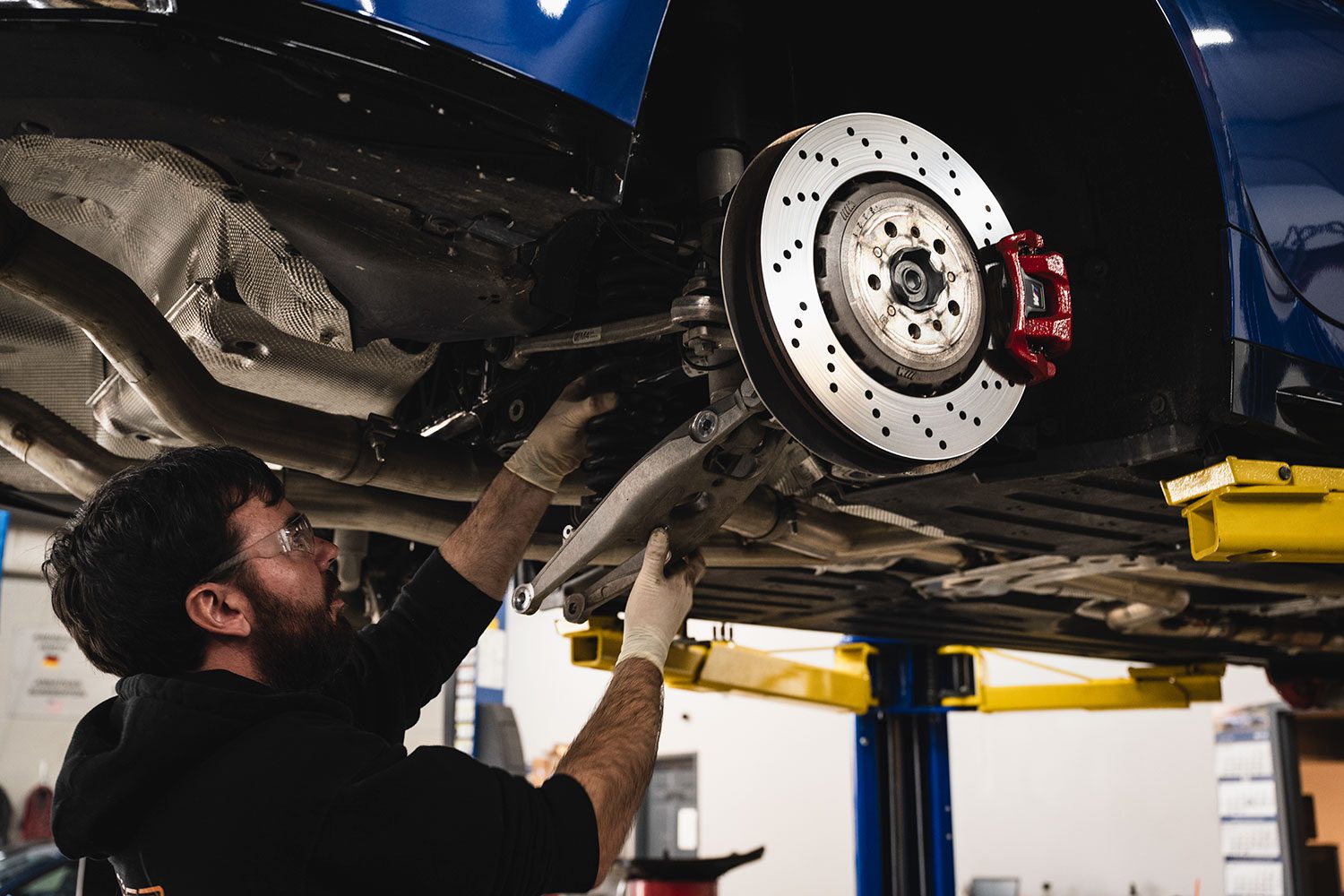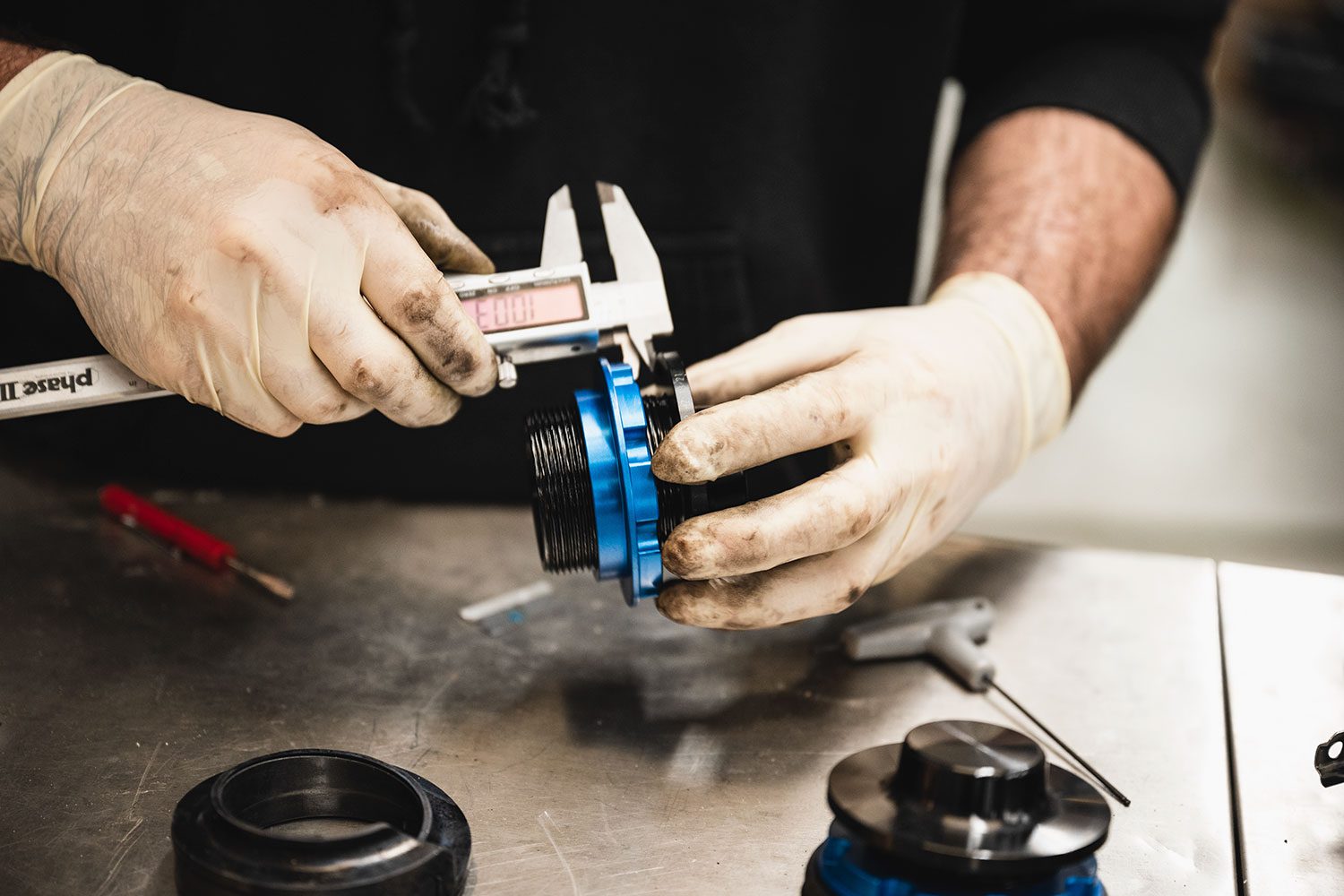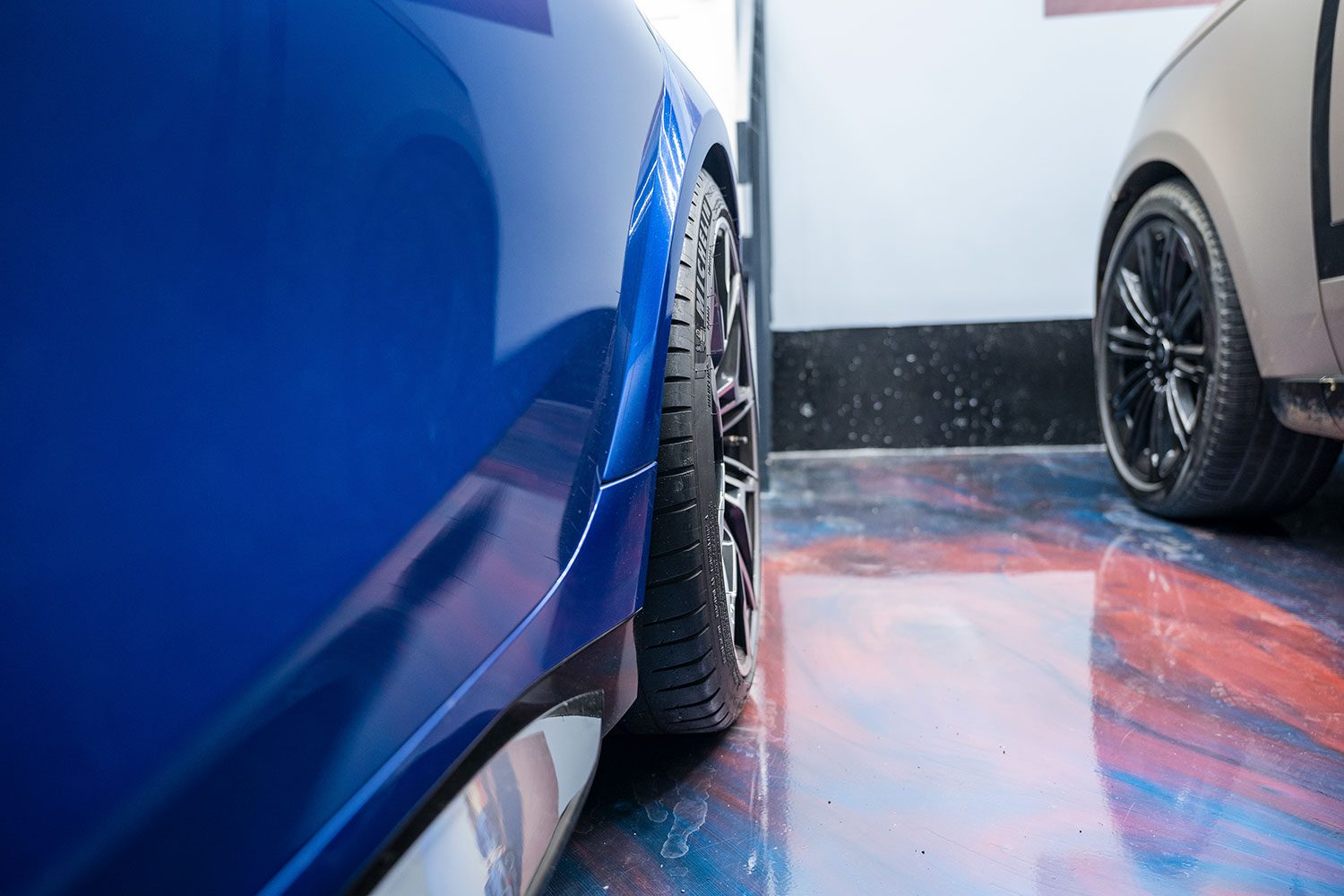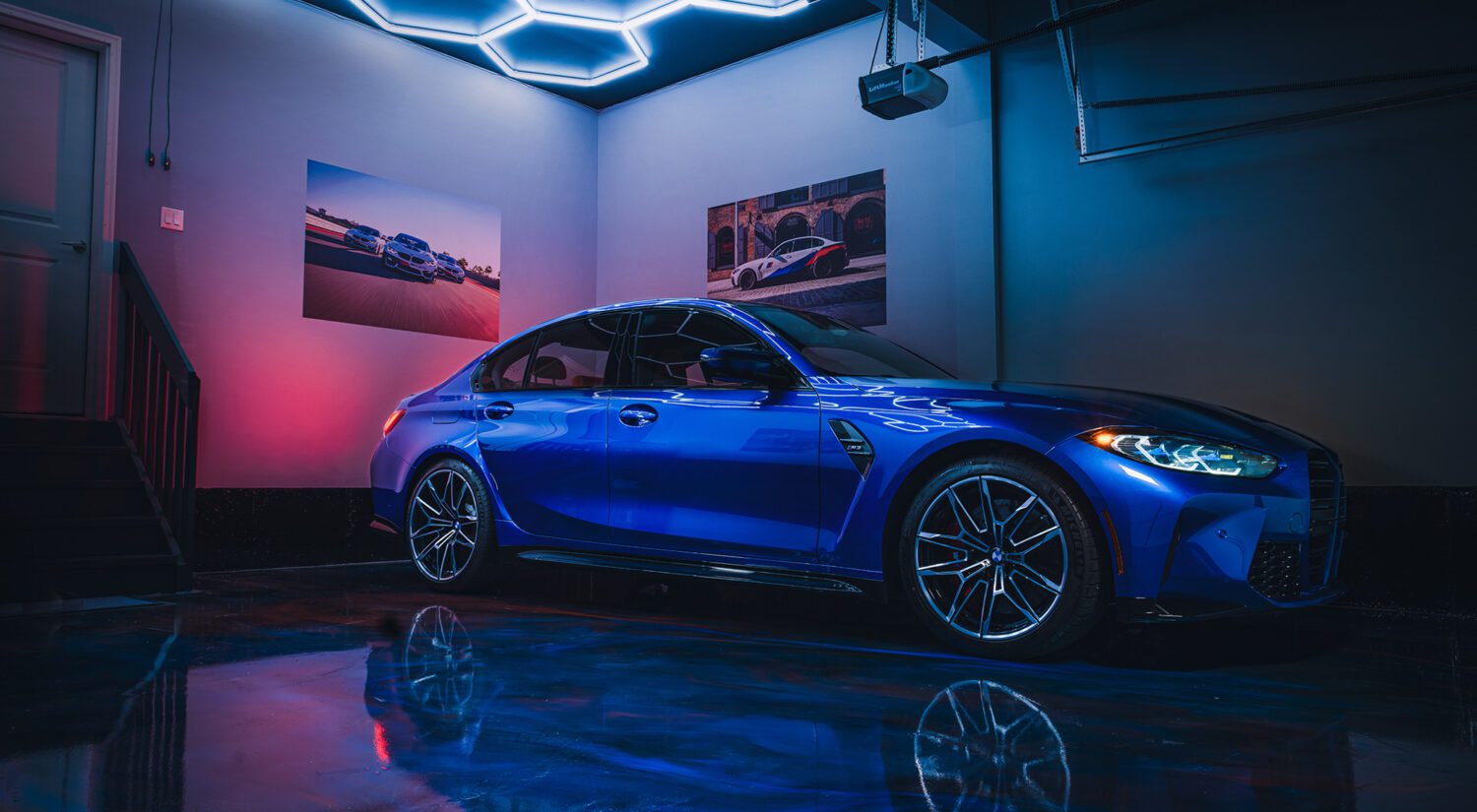We have an intake (woosh!). We have an exhaust (braap!). Now it’s time to ask: what to do about the G80 M3’s suspension? There’s a lot of options here, so I’ll go through my process, explain why I chose what I did, and we’ll take a trip to TySpeed for some expert installation.
Why do I need to touch a car that already has the ability to rip my eyeballs out of my head in hairpin turns? Because we can make it better.




What’s wrong with the stock G80 M3 suspension?
We’ll start here, and the answer is “Not much”.
Surprised?
BMW did an amazing job calibrating this car’s suspension. The front end grips very well, meaning it’s more hesitant to understeer than in M3s of yore. Body roll is well-controlled, and unless you live your life in SPORT +, it’s comfortable enough on public roads.
The G80 M3 has a pair of struts in the front and a multi-link system in the back. As a general rule, multi-link systems provide better handling abilities, but are more expensive to produce and package. The M5 gets a multi-link all around. We’re not so lucky.
The M3 also has EDC, or Electronic Dampening Control. While it doesn’t work as well as the magnetic system from GM, it still provides a noticeable difference in driving modes.
We can improve upon two things – aesthetics and responsiveness. Our new suspension should do the following:
- Lower the center of gravity on the car
- Increase turn-in response
- Look better
- Maintain EDC function
- Not rub anything




The options for the G80 M3’s suspension
Currently, we can go one of three routes. Each option requires a full wheel alignment after installation. It will take about 500 miles for the car to fully settle on the new springs, so don’t be too upset if it looks taller than you like right after you place them on.
Springs
The cheapest option is a set of new springs and sometimes bump stops. They are almost always more firm and shorter than the stock springs, thus lowering the car. The issue here is that you cannot adjust them, so if you don’t like how the car sits after installation for whatever reason, you’re stuck with them.


HAS kit (Height Adjustable Suspension)
Climbing up the ladder, the next option is a HAS kit. BMW M has opted to go this route, and the benefit here is the adjustability of the ride height even after the springs are installed. New spring perches and bump stops are also included. Currently, only BMW M and KW make HAS kits, but the KW one offers more range. KW does manufacture the M Performance kit for BMW, to their specs.


Coilovers
The struts on the front of an M3 are integral – the car would fall on its face without them. Compare the rear suspension to the front, and you’ll see the shock and spring separated in the rear because of the multilink setup.
I mention this here because a coilover looks like a strut, meaning the spring is “coiled over” the strut tube, but they offer adjustments beyond simply ride height like a HAS kit, including camber and rebound. On the M3, they can also delete the EDC system.
Coilovers are much more expensive than the other options here, and it would be unusual for a stock or near-stock car to need the flexibility a coilover system offers. But if you’re goin’ racin’, this would be the setup for you, as it lets you adjust the car’s feel to your driving style.
In the end, I selected the M Performance setup. In my opinion, none of the simple spring options allow the car to maintain its original civility, and can rub against the fender wall at full opposite lock. While the KW setup allows for a greater drop in ride height, I’m going with what BMW recommends here for an OEM+ look. It should be just enough. Plus, red springs with blue anodized perches match my car.
By the way, I purchased the kit from Baum, a BMW parts shop in Germany. I mention this because I’m amazed at how much cheaper the parts are from der mutherland. Worth the three-week wait for them to cross the Atlantic.
What about wheel spacers?


Everyone told me how beautiful they are, so I’ve added a set of 12mm spacers from Future Classic. They also offer 5, 15 or 18mm.
What they will do is push out the wheels a bit, so there isn’t so much of a gap from the body to the wheel face. On the G, it’s particularly noticeable in the front. I find it best to keep the setup square to maintain the car’s original balance, so its 12 mm all around. Anything less won’t be noticeable, and anything more may cause the wheels to rub in the front.
Side note, these also offer the benefit of giving me a bit more room to clean the brakes and wheel barrels. A set of aftermarket wheels will usually negate the need for spacers if they are wider, but results vary.


Installing the new G80 M3 Suspension


This is not a job you and your buddies can do on a Saturday afternoon with a six-pack as payment. As with my exhaust, I headed to TySpeed for expert service. Tyler and his crew are kind enough to let me film the process, share pizza, and in general let me bug them for 8 hours as I stick my face under the car.
In the northeast there are a lot of options to service a BMW, but Tyler Pappas, the owner – he gets it. A G82 M4 owner himself, and an expert behind the wheel, Tyler simply has the kind of enthusiasm for these cars that cannot be faked. The entire crew is both knowledgeable and helpful, eager to lend a hand to various projects. I’ve been to a lot of shops (I once shot a 2 million dollar Jaguar in the basement of a CVS, ok?), and it’s rare to find a good team that really gives a damn. This is no sponsorship either – I go here because it’s worth knowing the job will be done right the first time.
When Tyler busts out the micrometer to ensure the car will sit evenly, I know I made the right choice.


Without further ado, here’s the process.
Installing the rear M Performance Suspension parts on the G80 M3








































Installing the front M Performance Suspension parts on the G80 M3
While the rear of the car isn’t difficult to do, the front left me wondering why Tyler enjoys working on cars for a living. A front strut suspension makes things more challenging in any car, as does being attached to the bits that steer.




























Installing the Future Classic Wheel spacers
















Reviewing the BMW M Performance Suspension for the G80 M3
The M Performance suspension but does not have the ability to drop the car as low as the one KW makes. This is fine with me, as I did not want a slammed look and would prefer to keep the car’s civility in check. I’ve followed what BMW M recommends as far as the amount the car was lowered, though Tyler did a few additional clicks on the front end for an additional 10mm.


Immediately, I notice the M3 turns in much quicker, making it feel more responsive. Of course, the suspension has nothing to do with steering feel, but the firmer springs and lowered center of gravity help give the G80 improved dynamic ability.
As you’d expect, ride quality suffers. I’d call it much busier now, firmly bouncing over road imperfections. But it’s not unlivable. Put the car in comfort mode, and it will now feel as if you had it in sport when it was stock. Only people who like to punish themselves or hate their spouses would drive around in SPORT +. That’s what M modes are for. Overall, I don’t think there’s anything an M3 CS can do that my can now cannot.
The BMW M Performance HAS kit also keeps the stock warranty, and matches my car’s appearance perfectly. I’m actually disappointed you can’t see it.
As I continue this OEM+ build, I feel as if the performance aspect is pretty well-sorted. Time to tackle cosmetics.
The BMW M Performance Suspension after a few hundred miles












Want your car reviewed?
If you live in the tri-state area and want me to check it out, send me an email!
Support the cause
Commissions may be received for product links on this site. Help out if you can.
I use Nikon camera bodies and lenses, a Westcott Ice Light 2, Manfrotto tripod, B + W filters and an iMac Pro to make the art you see here.
Follow along on Instagram @machineswithsouls

















7 thoughts on “What’s the best suspension for the G80 M3?”